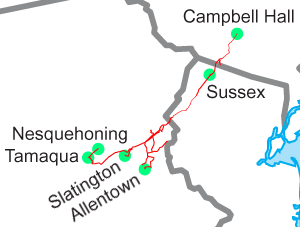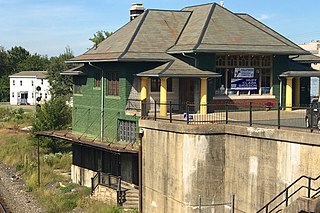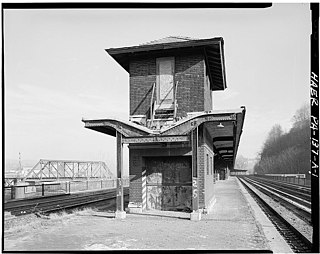Related Research Articles

The Delaware, Lackawanna and Western Railroad was a U.S. Class 1 railroad that connected Buffalo, New York, and Hoboken, New Jersey, a distance of 395 miles (636 km). Incorporated in Pennsylvania in 1853 primarily for the purpose of providing a connection between the anthracite coal fields of Pennsylvania's Coal Region and the large markets for coal in New York City. The railroad gradually expanded both East and West, eventually linking Buffalo with New York City.
The Lehigh Valley Railroad was a railroad built in the Northeastern United States to haul anthracite coal from the Pennsylvania Coal Region. The railroad was authorized on April 21, 1846 for freight and transportation of passengers, goods, wares, merchandise and minerals in the U.S. state of Pennsylvania and the railroad was incorporated and established on September 20, 1847 as the Delaware, Lehigh, Schuylkill and Susquehanna Railroad Company. On January 7, 1853, the railroad's name was changed to Lehigh Valley Railroad. It was sometimes known as the Route of the Black Diamond, named after the anthracite it transported. At the time, anthracite was transported by boat down the Lehigh River. The railroad ended operations in 1976 and merged into Conrail along with several northeastern railroads that same year.

The Reading Company was a railroad in eastern Pennsylvania and neighboring states that operated from 1924 until its 1976 acquisition by Conrail.

The Central Railroad of New Jersey, also known as the Jersey Central or Jersey Central Lines, was a Class I railroad with origins in the 1830s. It was absorbed into Conrail in April 1976 along with several other prominent bankrupt railroads of the Northeastern United States.

For the purposes of this article, the Jersey City area extends North to Edgewater, South to Bayonne and includes Kearny Junction and Harrison but not Newark. Many routes east of Newark are listed here.

The Raritan Valley Line is a commuter rail service operated by New Jersey Transit (NJT) which serves passengers in municipalities in Union, Somerset, and Hunterdon counties in the Raritan Valley region in central New Jersey, United States. The line's most frequent western terminus is Raritan station in Raritan. Some weekday trains continue farther west and terminate at the High Bridge station, located in High Bridge. Most eastbound trains terminate in Newark; passengers bound for New York make a cross-platform transfer. A limited number of weekday trains continue directly to New York.

The Lehigh and Hudson River Railway (L&HR) was the smallest of the six railroads that were merged into Conrail in 1976. It was a bridge line running northeast–southwest across northwestern New Jersey, connecting the line to the Poughkeepsie Bridge at Maybrook, New York with Easton, Pennsylvania, where it interchanged with various other companies.

The Lehigh & New England Railroad was a Class I railroad located in Northeastern United States that acted as a bridge line. It was the second notable U.S. railroad to file for abandonment in its entirety, the first being the New York, Ontario & Western Railway.
The Belvidere-Delaware Railroad was a railroad running along the eastern shore of the Delaware River from Trenton, New Jersey north via Phillipsburg, New Jersey to the small village of Manunka Chunk, New Jersey. It became an important feeder line for the Lehigh Valley Railroad's join to the Central Railroad of New Jersey, which was constructed into Phillipsburg, NJ at about the same time. This connected Philadelphia and Trenton, NJ at one end of the shortline railroad to the rapidly growing lower Wyoming Valley region, and via the Morris Canal or the CNJ, a slow or fast connection to New York City ferries crossing New York Harbor from Jersey City, NJ. In 1871 the CNJ leased various railroads in Pennsylvania, most from the Lehigh Coal & Navigation Company allowing the CNJ to penetrate to the upper Wyoming Valley, over some stretches, competing directly with the Lehigh Valley Railroad and with the Lehigh Canal and the trunk road connection of the Belvidere Delaware Railroad to New York became less profitable since Philadelphia connected more easily to Northeastern Pennsylvania thereafter without needing a double-crossing of the Delaware River; a general revenue decline ensued, leading to the Pennsylvania Railroad acquiring the rights, where it served as part of the Pennsylvania Railroad (PRR) system, carrying mainly anthracite coal and iron ore from northeastern Pennsylvania to population centers along the coast.
The Allentown Railroad was a rail line proposed in the 1850s to connect the Central Railroad of New Jersey at Allentown with the Pennsylvania Railroad's main line across the Allegheny Mountains. Though grading was almost entirely finished, the project was halted by the Panic of 1857, and the completion of the East Pennsylvania Railroad in 1859 made the Allentown Railroad's proposed line largely redundant. As a result, track was never laid on most of the line. The small portion that did became a branchline of the Reading Company from Topton to Kutztown, and was nominally owned by the Allentown Railroad until the Reading dissolved it in 1945 to simplify corporate bookkeeping. Other Reading subsidiaries also laid track on parts of the right-of-way elsewhere along the route.
The Lehigh Division is a major freight low grade rail line owned and operated by the Reading Blue Mountain and Northern Railroad in the U.S. state of Pennsylvania that runs from Lehighton, Pennsylvania to Dupont, Pennsylvania; it originally ran from Lehighton to Mehoopany, Pennsylvania. The Lehigh Division was formed in 1993 by Conrail from the Lehigh Line, officially the former main line of the Lehigh Valley Railroad (LVRR) that has absorbed former Central Railroad of New Jersey (CNJ) main line trackage and former Lehigh and Susquehanna Railroad (L&S) main line trackage into its system under Conrail; the Lehigh Line today is owned by the Norfolk Southern Railway and connects to the Lehigh Division at Lehighton.
The following is a brief history of the North American rail system, mainly through major changes to Class I railroads, the largest class by operating revenue.

Allentown is a defunct train station in Allentown, Pennsylvania. It was constructed by the Central Railroad of New Jersey (CNJ) and Reading Railroad from 1888–1889. The station closed in 1967 with the cessation of CNJ passenger service. The station is located one block east of the Lehigh Valley Railroad's Allentown station.

The Lehigh and Susquehanna Railroad is a defunct railroad that operated in eastern Pennsylvania during the nineteenth and twentieth centuries. The company was a subsidiary of the Lehigh Coal & Navigation Company (LC&N), but for much of its lifetime leased by the Central Railroad of New Jersey. It was founded in 1837 to carry coal from the North Branch Division of the Pennsylvania Canal to the Lehigh Canal, but would later be extended to the Delaware River at Easton, Pennsylvania. It was conveyed to Conrail in 1976.

The Nesquehoning Valley Railroad Company, herein called the Nesquehoning Valley Railroad (NVRR), is now a fallen flag standard-gauge, steam era shortline railroad built as a coal road to ship the Anthracite mined in the Southeastern Coal Region on either side of the Little Schuylkill River tributary Panther Creek and the history making coal towns of the Panther Creek Valley down the Lehigh River transportation corridor to the Eastern seaboard.

The Lehigh Line is a railroad line in central New Jersey and northeastern Pennsylvania, in the United States. It is owned and operated by the Norfolk Southern Railway. The line runs west from the vicinity of the Port of New York and New Jersey to the Susquehanna River valley at the south end of the Wyoming Valley Coal Region. Administratively it is part of Norfolk Southern's Keystone Division (Harrisburg) and is also part of the Crescent Corridor. As of 2021 the line is freight-only, although there are perennial proposals to restore passenger service over all or part of the line.

Phillipsburg Union Station is an inactive railroad station in Phillipsburg, New Jersey, United States, at 178 South Main Street. Opened in 1914, Union Station was built by the Delaware, Lackawanna & Western Railroad (DL&W) and shared with the Central Railroad of New Jersey (CNJ) and was situated where the lines merged before the bridge crossing the Delaware River. Designed by Frank J. Nies, the architect who produced many of DL&W stations now listed state and federal registers of historic places, the 2 1/2 story, 3 bay brick building is unusual example of a union station and a representation of early 20th century Prairie style architecture. The Phillipsburg Union Signal Tower, or PU Tower, is nearby.

Easton is a defunct train station in Easton, Pennsylvania. It was originally built by the Lehigh Valley Railroad. As of 2017, the structure still exists and was blighted for at least 20 years, since its closing in the 1970s. The city of Easton obtained permission from Norfolk Southern Railway to clean up the property. The location only recently became a focal point for the city with the opening of Interstate 78 in the 1990s.

The Hauto Tunnel, dug in 1871–72, was a 1.1-mile-long (1.8 km) single-track railway tunnel crossing under the barrier ridge of Nesquehoning Mountain between Lansford, Pennsylvania, in the Panther Creek Valley and the Central Railroad of New Jersey trackage near the dam of the Hauto Reservoir impoundment about 1.3 miles (2.1 km) above Nesquehoning, Pennsylvania. The tunnel was significant for cutting nearly 15 difficult mountainous miles (24 km) off the trip to the Lehigh Canal terminal or, by rail, to other eastern coal companies, in the era when anthracite was the king of energy fuels.

Bethlehem is a disused train station in Bethlehem, Pennsylvania. It was constructed by the Central Railroad of New Jersey (CNJ) in 1873. Passenger service to the station ended in 1967. A restaurant opened within the station in 1976, and the building has continued to serve that role through several changes in ownership. The station is located on the north side of the Lehigh River, near Monocacy Creek, east of Main Street and south of East Lehigh Street. Another disused station, Union Station, is located on the south side of the Lehigh River.
References
- ↑ "Lowerluzernecounty.com". Lowerluzernecounty.com. Retrieved 2022-06-05.
- ↑ "31 Mar 1972, 3 - at". Newspapers.com. 1972-03-31. Retrieved 2022-06-05.